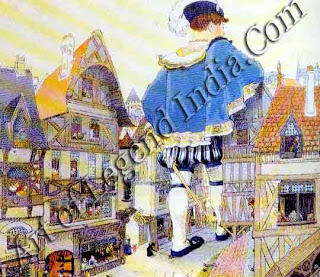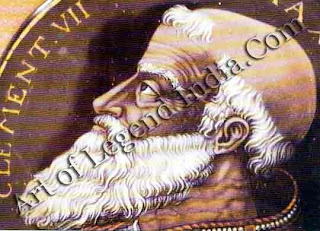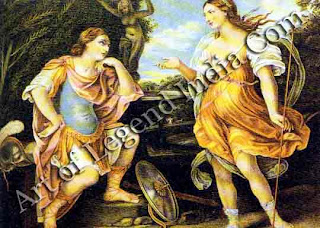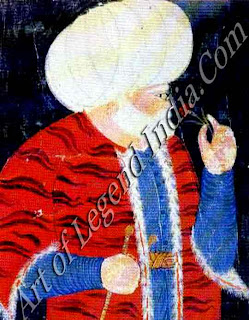 So the
solution to his problem lay in the king's own hands. He had in any case fallen
in love with Anne Boleyn and, knowing her to be pregnant, married her secretly
on 25 January, thus ensuring that his son would be legitimate and the
acknowledged heir to the throne.
So the
solution to his problem lay in the king's own hands. He had in any case fallen
in love with Anne Boleyn and, knowing her to be pregnant, married her secretly
on 25 January, thus ensuring that his son would be legitimate and the
acknowledged heir to the throne. German Great Artist Hans Holbein - A Year in the Life 1533
Posted by
Art Of Legend India [dot] Com
On
1:44 AM
The
year was dominated by the events surrounding King Henry VIII's quest for a male
heir. Convinced that Catherine of Aragon was incapable of producing a son that
would survive, Henry set about securing a divorce that would free him to marry
Anne Boleyn. To do so, he had to split England from the Church of Rome.
By the
beginning of 1533, Anne Boleyn was pregnant, a fact which precipitated a crisis
in Henry VIII's matrimonial affairs. He had for some years been anxious to
obtain a divorce from his first wife, Catherine of Aragon. His brother's widow,
and six years older than Henry, Catherine had given birth to six children, but
only Henry's daughter Mary had survived.
Henry
desperately wanted to produce a male heir and convinced himself that the deaths
of Catherine's children were God's punishment for an improper marriage. Under
normal circumstances, Pope Clement VII would probably have obliged Henry's
request for a divorce the papacy understood in such cases and especially when
they involved matters of state. But Catherine was the aunt of Charles V. Holy
Roman Emperor, who, quite apart from feelings of family loyalty, had very high
moral standards and would not hear of a divorce. The sanctions which the
emperor could bring to bear on the papacy far outweighed any pressure that the
king could exert.
 So the
solution to his problem lay in the king's own hands. He had in any case fallen
in love with Anne Boleyn and, knowing her to be pregnant, married her secretly
on 25 January, thus ensuring that his son would be legitimate and the
acknowledged heir to the throne.
So the
solution to his problem lay in the king's own hands. He had in any case fallen
in love with Anne Boleyn and, knowing her to be pregnant, married her secretly
on 25 January, thus ensuring that his son would be legitimate and the
acknowledged heir to the throne.
But the
question of Henry's marriage to Catherine remained unresolved. There was no
hope of obtaining a divorce from Rome, so it had to be achieved through the
Archbishop of Canterbury. As luck would have it, the archbishop's chair was
vacant: Archbishop Warham had died only the previous year. The king appointed
Thomas Cranmer, a brilliant young Cambridge scholar of divinity who had, as one
of the king's chaplains, been canvassing support for a divorce.
On 30
March, the new archbishop was formally consecrated. Although he took the usual
oath of obedience to the pope, he qualified it by a formal assertion that he
was not bound to do anything contrary to the law of God or to the king, realm,
laws, and prerogatives of England. This, together with the hurriedly passed Act
of Appeals, which recognized the English primate as the ultimate authority for
English ecclesiastical law without reference to Rome, cleared the way for Henry's
divorce.
Immediately
after his consecration, Cranmer presided over meeting which decided that
Henry's marriage to Catherine was contrary to divine law, and on 10 May he
opened his court at Dunstable. Catherine refused to recognize Cranmer's
authority to try a cause that was before the papal court and did not attend. On
23 May, the archbishop passed sentence, pronouncing that the pope had no power
to license marriages such as Henry's, and that the king and Catherine had never
been husband and wife.
Five
days later, Cranmer declared Henry and Anne Boleyn lawfully married, and on 1
June Anne was crowned queen in Westminster Abbey. On 11 July, in a belated
effort to protect the dignity of the Church, the pope prepared the sentence of
excommunication which was delivered in September. Henry had, in effect, broken
any remaining links with Rome: the Reformation in England was under way.
The
king's personal desires in this matter were, coincidentally, in accordance with
the aspirations of his people who, in a wave of nationalism and disillusionment
with the Church, were keen to rid themselves of the influence of Rome. In other
matters there was no such accordance. Catherine's humiliation was deeply
resented by the people, Europe was shocked, and pope and emperor had been
insulted.
But the
final irony of this tale did not become apparent until three months after
Anne's coronation. In the afternoon of Sunday 7 September, Queen Anne gave
birth to a daughter. On the following Wednesday, the child was christened
Elizabeth the future Queen Elizabeth I of England.
Writer
– Marshall Cavendish
Subscribe to:
Post Comments (Atom)















0 Response to "German Great Artist Hans Holbein - A Year in the Life 1533 "
Post a Comment